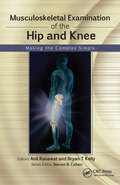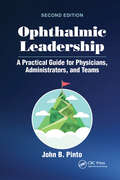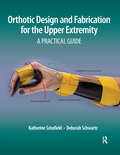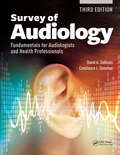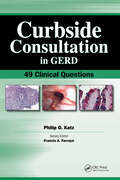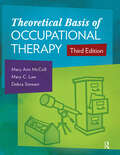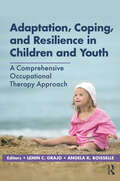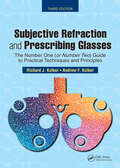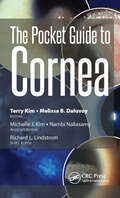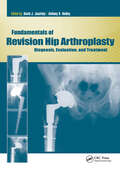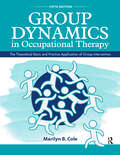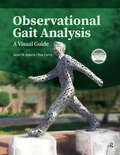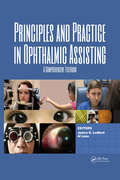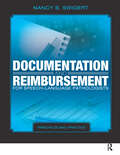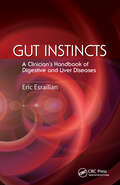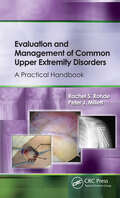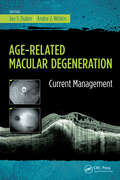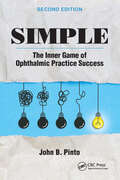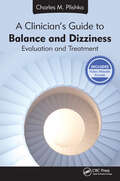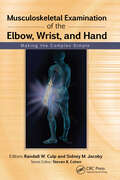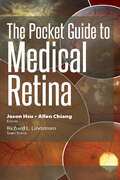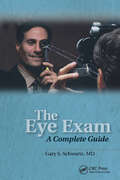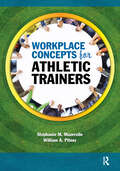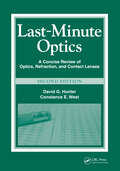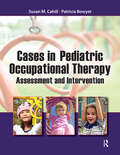- Table View
- List View
Musculoskeletal Examination of the Hip and Knee: Making the Complex Simple
by Bryan Kelly Anil RanawatThe physical examination of the hip and knee can be a complex topic for professionals with all levels of clinical experience. How can advance concepts be taught in a user-friendly, clear format, while still providing necessary information for effective diagnosis and treatment of the hip and knee?Musculoskeletal Examination of the Hip and Knee: Making the Complex Simple by Drs. Anil Ranawat and Bryan T. Kelly answers these questions. Written by experts, this easy-to-carry book provides a thorough review of the most common pathologic hip and knee conditions, techniques for diagnosis, as well as the appropriate treatment for each condition.Musculoskeletal Examination of the Hip and Knee: Making the Complex Simple contains clear photographic demonstrations, tables, and charts throughout its pages, allowing a thorough and concise examination of the hip and knee.A glance at some of what is covered inside: Physical Examination Basics and specific tests of the physical examination of the hip and knee General Imaging Basics of general imaging of the hip and knee Common Conditions Arthroscopic management of labral tears, snapping hip syndromes, meniscal tears, and more Musculoskeletal Examination of the Hip and Knee: Making the Complex Simple contains essential information to successfully take a complex subject and bring it to a level that will be welcomed by orthopedic residents, attendings, physical therapists, athletic trainers, medical students in training, and other health care providers.
Ophthalmic Leadership: A Practical Guide for Physicians, Administrators, and Teams
by John B. PintoOphthalmic practices have many types of leaders, functioning at all levels of the organization. Ophthalmic Leadership: A Practical Guide for Physicians, Administrators, and Teams, Second Edition can provide each of these leaders with the tools to be more decisive, motivating, and effective.John B. Pinto, America’s most published author on the business of ophthalmology, has firsthand experience with the best and worst practice leadership habits from his decades of experience as an ophthalmic practice consultant. He has coached countless physician and lay leaders to the next level of their careers. Together with his team of more than 20 expert contributors, Pinto covers every aspect of leadership in ophthalmology, no matter the size of the practice or the current experience of the team.Chapters include: What Do You Believe in? Developing a List of Core Values for Your Practice Grooming and Moving Line Staff Up to Middle Management Contingency Planning in a Less-Certain Environment Leading Your Team Past the Inevitable Conflicts of Practice Life Everyone in ophthalmology can benefit from the lessons inside Ophthalmic Leadership: A Practical Guide for Physicians, Administrators, and Teams, Second Edition—from the rising ophthalmic technician or department manager, to the managing partner, and even the most seasoned practice administrator.“The book you now hold is a wonderful opportunity to rededicate yourself to your professional development as a leader and to the success of your organization.”From the Foreword by Richard L. Lindstrom, MD
Orthotic Design and Fabrication for the Upper Extremity: A Practical Guide
by Katherine Schofield Deborah SchwartzOrthotic Design and Fabrication for the Upper Extremity: A Practical Guide by Drs. Katherine Schofield and Deborah Schwartz is a unique guide that illustrates orthotic design and fabrication in a clear step-by-step fashion by presenting printed textual material along with instructional videos. The first chapters lay the foundation for orthotic design and detail the anatomical knowledge and background information that is required before molding orthoses on clients. Each chapter explores a specific part of the upper extremity, describes several common clinical diagnoses, and highlights typical orthoses that might be utilized to immobilize and protect it. Together, these chapters communicate core, foundational knowledge for the use of orthoses as an intervention in occupational therapy practice. The instructional videos also emphasize the application of biomechanical, anatomic, and clinical constructs in orthotic design, fabrication, and evaluation. The textbook and video content work together enabling students and entry-level practitioners to learn with visual and versatile resources. University faculty members will gain access to ample activities and exercises to augment their classroom and laboratory teaching. This allows for more efficient use of time and appeals to the learning styles of current and future students. This text includes: Chapters devoted to specific type of orthosis for parts of the upper extremity linked to step -by -step instructional videos Case studies to promote a grasp of the knowledge and application to the development of clinical reasoning skills Multiple choice and short answer review questions and activities for most chapters Presentation of current evidence to support the use of the specific orthoses in clinical practice Patterns that can be replicated and check out sheets to critique each orthosis The combination of text materials and instructional video material makes Orthotic Design and Fabrication for the Upper Extremity: A Practical Guide a uniquely valuable resource for occupational therapy students, new graduates, and novice clinicians.
Survey of Audiology: Fundamentals for Audiologists and Health Professionals, Third Edition
by David DeBonis Constance DonohueFor nearly 20 years, Survey of Audiology: Fundamentals for Audiologists and Health Professionals has provided both the breadth of an introductory survey of audiology and the depth of a detailed textbook. Inside, Drs. David DeBonis and Constance Donohue have combined their years of work in clinical settings and their experience teaching audiology into a textbook intended to give students all the knowledge they’ll need in the most accessible and comprehensible format.In this Third Edition, updates have been made to include the latest information on the most current topics in audiology, including cognition and hearing loss, pharmacology, central auditory processing disorders, wireless technology, hearing aid accessibility, tinnitus, genetics and biotechnology, and noise exposure.New and updated inside the Third Edition: Ethical considerations for audiologists Auditory Neuropathy Spectrum Disorder (ANSD) Auditory processing disorders Tinnitus Evidence-based genetic counseling The latest hearing aid technology How to critically review evidence in literature and studies Included with the text are online supplemental materials for faculty use in the classroom.With its extensive glossary, numerous case examples, chapter abstracts, learning objectives, and questions for discussion, Survey of Audiology is designed to support learning and reinforce key points in every way. The text also works to integrate the humanistic aspects of audiology with the scientific ones into holistic discussions of assessment and intervention. Through this approach, students will learn to always remember that there is a person behind each set of symptoms.While aspiring audiologists will appreciate the depth of Survey of Audiology: Fundamentals for Audiologists and Health Professionals, Third Edition, students of speech-language pathology and other health professions looking for a crash course in audiology will benefit from its readability and wide scope.
Curbside Consultation in GERD: 49 Clinical Questions (Curbside Consultation in Gastroenterology)
by Philip O. KatzAre you looking for concise, practical answers to questions that are often left unanswered by traditional GERD references? Are you seeking brief, evidence-based advice for complicated cases or complications? Curbside Consultation in GERD: 49 Clinical Questions provides quick and direct answers to the thorny questions commonly posed during a “curbside consultation” between colleagues.Dr. Philip Katz has designed this unique reference, which offers expert advice, preferences, and opinions on tough clinical questions commonly associated with GERD. The unique Q&A format provides quick access to current information related to GERD with the simplicity of a conversation between two colleagues. Numerous images, diagrams, and references are included to enhance the text and to illustrate the treatment of GERD patients.Curbside Consultation in GERD: 49 Clinical Questions provides information basic enough for residents while also incorporating expert advice that even high-volume clinicians will appreciate. Gastroenterologists, fellows and residents in training, surgical attendings, and surgical residents will benefit from the user-friendly and casual format and the expert advice contained within.Some of the questions that are answered: Can medical therapy alter the natural history of Barrett’s esophagus? Can antireflux surgery alter the natural history of Barrett’s esophagus? How does pregnancy affect GERD? Is GERD in pregnancy a risk for long-term reflux? What is the association of obesity and GERD? What are the so-called extraesophageal manifestations of GERD? Is there a gender difference in reflux disease? Does this affect treatment?
Theoretical Basis of Occupational Therapy
by Mary Ann McColl Mary C. Law Stewart DebraTheoretical Basis of Occupational Therapy, Third Edition shows the results of an exhaustive review of international peer-reviewed literature in occupational therapy and provides a synthesis of current theoretical developments in occupational therapy and occupational science. This helps occupational therapy students, researchers, and clinicians understand how to think about occupation, the many factors that affect occupation, and how to use occupation therapeutically to promote health and well-being. Unlike earlier editions, this updated Third Edition debuts during a time when even casual searchers can readily find huge amounts of information on the internet with the click of a search button. To remain relevant, this Third Edition goes beyond simply providing an annotated bibliography of peer-reviewed literature by also giving readers an analysis and synthesis of these documents in a clear and compelling organizational structure. Led by Mary Ann McColl, Mary Law, and Debra Stewart, Theoretical Basis of Occupational Therapy, Third Edition also offers an appendix that catalogs the literature included. In each of the determinants of occupation chapters, the contributors have extracted key themes, followed threads of theoretical development, reflected on external influences of occupational therapy theory, and commented particularly on developments over the last 15 years. New Features of the Third Edition: An updated database of articles A look at both determinants and consequences of occupation Further development of the three metaphors (the filing cabinet, toolbox, and telescope) that help organize and retrieve occupational therapy theory New contributing authors to supplement content New sections about the major named occupational therapy models Theoretical Basis of Occupational Therapy, Third Edition offers a classification system for theory, a digest of new developments in each area of the classification system, and a commentary on theoretical developments across theory areas that advance the knowledge and expertise of the profession as a whole.
Adaptation, Coping, and Resilience in Children and Youth: A Comprehensive Occupational Therapy Approach
by Lenin Grajo Angela BoisselleA groundbreaking text for occupational therapists, Adaptation, Coping, and Resilience in Children and Youth: A Comprehensive Occupational Therapy Approach offers a different perspective in addressing the ways children and youth with a variety of conditions and personal contexts can have more optimized participation in everyday life. This text is essential for occupational therapy graduate students, instructors, and pediatric clinicians.Drs. Lenin C. Grajo and Angela K. Boisselle provide a comprehensive, strength-based approach in addressing the ability of children to adjust to a variety of challenges encountered in daily life across multiple environments and contexts. Adaptation, Coping, and Resilience in Children and Youth includes best and evidence-based practices for assessment and intervention.Included in the book: Collaborative approach with families How to build relationships through interprofessional collaboration (teachers, health care team, and community) Global perspectives of adaptation, coping, and resilience Case applications and essential considerations for occupational therapists The text also covers underexplored contexts such as those who have been bullied, children and youth who are LGBTQ and gender expansive, children and youth of color, those who live as a member of a migrant family, and those who have lived with and through adverse childhood experiences.Adaptation, Coping, and Resilience in Children and Youth: A Comprehensive Occupational Therapy Approach is a necessary text that offers timely best and evidence-based practices for assessment and intervention for occupational therapy students and professionals.
Subjective Refraction and Prescribing Glasses: The Number One (or Number Two) Guide to Practical Techniques and Principles, Third Edition
by Richard KolkerBasic refraction is a foundational part of ophthalmology, and yet beginning ophthalmology residents and ophthalmic technicians are often left on their own to learn the finer points. Despite being core skills, the techniques and practical aspects of subjective refraction and prescribing glasses are often developed by trial and error, if they are developed at all.Subjective Refraction and Prescribing Glasses: The Number One (or Number Two) Guide to Practical Techniques and Principles, Third Edition is designed as a complete guide to those essential skills, offering everything from basic terminology to tips, tricks, and best practices. This updated Third Edition has been expanded in every section with thoughtful, practical advice, and has case scenarios, in a question and answer format, of situations encountered with real-world patients. It is the most comprehensive review of clinical subjective refraction to date. Drs. Richard Kolker and Andrew Kolker together have nearly 50 years of experience in the practice of ophthalmology and bring both the fresh eyes of a beginning ophthalmologist and the experience of a seasoned veteran to this Third Edition. While new residents and technicians will appreciate the thorough explanation of refractive fundamentals, even expert ophthalmologists will appreciate the practical tips that may have never occurred to them. Included are: Very clear, easy-to-read, practical explanations of the subjective refraction process Basic practical optics to explain the steps of subjective refraction The Jackson Cross Cylinder made easy to understand and use Plus and mInus cylinder methods discussed separately and color coded for quick identification An Appendix with a primer on retinoscopy and how to use the manual lensometer The art of subjective refraction and prescribing glasses Subjective Refraction and Prescribing Glasses: The Number One (or Number Two) Guide to Practical Techniques and Principles, Third Edition is the definitive guide to the often neglected skills involved in clinical subjective refraction. Residents and technicians will find it a critical guide in their learning process, but even seasoned ophthalmologists can benefit from the tips and tricks enclosed within.
The Pocket Guide to Cornea (Pocket Guides)
by Terry Kim Melissa DaluvoyAre you a medical student or resident trying to absorb as much information on the cornea as efficiently as possible? Are you an ophthalmologist who needs fast facts on a specific corneal disease? Reach into your lab coat pocket and pull out The Pocket Guide to Cornea for easy access to the information you need right now. Drs. Terry Kim and Melissa Daluvoy have designed this book as the most effective way to take in the information on the cornea for the entire spectrum of eye care providers. Medical students and residents will be pleased to have this accessible, high-yield handbook during their rotations to familiarize themselves with cornea findings and diagnoses, while seasoned ophthalmologists will be glad to have it as a refresher or quick reference guide to current diagnostic and treatment standards. Contained within The Pocket Guide to Cornea is the most essential information on the cornea organized in the most efficient ways. Each chapter is arranged in bullet-point style, for quick access to the relevant information, and is accompanied by numerous color photographs to help with recognition and retention.Topics covered: Basic examination techniques Anterior segment testing and imaging Common to rare cornea diseases Common procedures and surgeries The entire spectrum of eye care providers can benefit from the high-yield, quick-access information contained within The Pocket Guide to Cornea, whether they are learning about the cornea for the first time or they just need a quick refresher on an obscure corneal disease.
Fundamentals of Revision Hip Arthroplasty: Diagnosis, Evaluation, and Treatment
by David Jacofsky Anthony HedleyFundamentals of Revision Hip Arthroplasty: Diagnosis, Evaluation, and Treatment is a unique and very timely book designed for surgeons who are beginning to more commonly encounter hip revisions in their practice. Unlike many traditional books on revision, Fundamentals of Revision Hip Arthroplasty does not focus on the most difficult and challenging of cases. Rather, Fundamentals of Revision Hip Arthroplasty is intended to guide the surgeon in the evaluation of the failed or painful total joint replacement, review basic tenants and surgical principles of revision arthroplasty, and guide the surgeon in determining whether a given case is one that should be managed or is best referred to a tertiary orthopedic center.Along with their 32 contributors, Dr. David J. Jacofsky and Dr. Anthony K. Hedley provide detailed information inside Fundamentals of Revision Hip Arthroplasty, including appropriate preoperative evaluation, equipment requirements, surgical planning, need for augments and allograft, and surgical techniques.Surgeons will be tackling hip revision surgery more frequently as the number of these cases is exponentially increasing. Fundamentals of Revision Hip Arthroplasty provides a “go-to” resource to turn to for guidance by community arthroplasty surgeons, arthroplasty fellows, and residents.
Group Dynamics in Occupational Therapy: The Theoretical Basis and Practice Application of Group Intervention
by Marilyn B. ColeIn occupational therapy practice, well designed groups represent social and cultural contexts for occupational performance in everyday life. Group Dynamics in Occupational Therapy: The Theoretical Basis and Practice Application of Group Intervention, the best-selling text for over 25 years by Marilyn B. Cole, has been updated to a Fifth Edition, offering strategies and learning tools to place clients in effective groups for enhanced therapeutic interventions. Updated to meet the AOTA’s Occupational Therapy Practice Framework, Third Edition, this Fifth Edition provides guidelines for occupational therapy group design and leadership and guides application of theory-based groups. The theory section clarifies how occupation based models and frames of reference change the way occupational therapy groups are organized and how theory impacts the selection of group activities, goals, and outcomes. Recent examples and evidence are added in this Fifth Edition to reflect the design and use of groups for evaluation and intervention within the newly evolving paradigm of occupational therapy. The third section focuses on the design of group protocols and outlines a series of group experiences for students. These are intended to provide both personal and professional growth, as well as a format for practice in group leadership, self-reflection, cultural competence, and community service learning. A new chapter focusing on the recovery model and trauma-informed care suggests ways for occupational therapists to design group interventions within these broadly defined approaches. Cole’s 7-step format for occupational therapy group leadership provides a concrete, user-friendly learning experience for students to design and lead theory based groups. The settings for which students can design group interventions has been updated to include current and emerging practice settings. Included with the text are online supplemental materials for faculty use in the classroom. With a client-centered theoretical approach, Group Dynamics in Occupational Therapy: The Theoretical Basis and Practice Application of Group Intervention, Fifth Edition continues a 25-year tradition of education for occupational therapy and occupational therapy assistant students and clinicians.
Observational Gait Analysis: A Visual Guide
by Janet Adams Kay CernyObservational Gait Analysis: A Visual Guide is a pedagogical manual and video library that provides a thorough review of key characteristics of normal gait that are important for observational clinical gait analysis.This visual guide by Drs. Jan Adams and Kay Cerny has unique features to further the understanding of examination and evaluation of the subject’s gait, such as: Normal and pathological gait are described using figures and graphs, along with gait videos and 3D graphs to show the kinematics and kinetics described Functional tools used as outcome measures to evaluate gait performance in the community environment including Dynamic Gait Test, Six Minute Walk Test, Ten Meter Walk Test, to name a few In addition to the unique features, the pathological gait section presents descriptions of gait deviations included in a new clinical Observational Gait Analysis (OGA) tool, along with probable causes for each of the deviations. Case studies are presented using this new tool for examining and evaluating the subject’s gait. Bonus!Students will be able to watch antero-posterior and lateral videos of individuals with gait deviations, complete the OGA tool to document their gait examination, and evaluate their examination results. They will then validate their observational skills by comparing their results to the text’s case study OGA results and the skeletal model and motion and moment graphs completed by 3D instrumented analysis of the same individual. The student will then compare their evaluation of causes of deviations to that included in the case study. Included with the text are online supplemental materials for faculty use in the classroom.Observational Gait Analysis: A Visual Guide will be the go-to resource for clinical tools to analyze gait for physical therapy and prosthetic and orthotic students and clinicians, as well as other professionals interested in the clinical analysis of persons with gait disability.
Principles and Practice in Ophthalmic Assisting: A Comprehensive Textbook
by Janice K. Ledford Al LensTime is an incredibly valuable resource for ophthalmic and para-optometric personnel, whether they are still studying on their way to certification or they are already in the trenches in daily practice. To keep up, they need a single, cohesive text containing everything they need to learn. Principles and Practice in Ophthalmic Assisting: A Comprehensive Textbookmeets that need, covering all subject areas in detail while also maintaining a readable, user-friendly style. Editors Janice Ledford and Al Lens have gathered a prestigious team of over 40 contributors, all of them ophthalmic and optometric medical personnel, who actively perform the tasks they write about. Their time-tested expertise is like having a group of specialists right by your side to show how it’s done and answer questions. From A-scan to zygoma, Principles and Practice in Ophthalmic Assisting: A Comprehensive Textbookincludes everything ophthalmic and para-optometric personnel need to know to effectively perform their duties, assist their patients, and advance their careers. Each chapter is written in a friendly manner and follows an established framework, making it easy to digest any new information or as a quick reference to the material needed. Chapters also include valuable “tricks of the trade” that could only come from authors with intimate knowledge of their topics. Topics covered: General ophthalmic knowledge Ophthalmic skills Optical skills Ophthalmic medical sciences Surgical services and skills Administrative skills Whether perfecting current skills, learning new ones, or studying for exams, Principles and Practice in Ophthalmic Assisting: A Comprehensive Textbook makes both a perfect learning tool for students and a complete reference tool for staff whether they are new to the eyecare industry or have years of experience.
Documentation and Reimbursement for Speech-Language Pathologists: Principles and Practice
by Nancy SwigertAlthough it is the least noticed by patients, effective documentation is one of the most critical skills that speech-language pathologists must learn. With that in mind, Documentation and Reimbursement for Speech-Language Pathologists: Principles and Practiceprovides a comprehensive guide to documentation, coding, and reimbursement across all work settings.The text begins with section 1 covering the importance of documentation and the basic rules, both ethical and legal, followed by an exploration of the various documentation forms and formats. Also included are tips on how to use electronic health records, as well as different coding systems for diagnosis and for procedures, with an emphasis on the link between coding, reimbursement, and the documentation to support reimbursement.Section 2 explains the importance of focusing on function in patient-centered care with the ICF as the conceptual model, then goes on to cover each of the types of services speech-language pathologists provide: evaluation, treatment planning, therapy, and discharge planning. Multiple examples of forms and formats are given for each.In section 3, Nancy Swigert and her expert team of contributors dedicate each chapter to a work setting in which speech-language pathologists might work, whether adult or pediatric, because each setting has its own set of documentation and reimbursement challenges. And since client documentation is not the only kind of writing done by speech-language pathologists, a separate chapter on “other professional writing” includes information on how to write correspondence, avoid common mistakes, and even prepare effective PowerPoint presentations.Each chapter in Documentation and Reimbursement for Speech-Language Pathologists contains activities to apply information learned in that chapter as well as review questions for students to test their knowledge. Customizable samples of many types of forms and reports are also available.Included with the text are online supplemental materials for faculty use in the classroom.Documentation and Reimbursement for Speech-Language Pathologists: Principles and Practice is the perfect text for speech-language pathology students to learn these vital skills, but it will also provide clinical supervisors, new clinicians, and speech-language pathologists starting a private practice or managing a department with essential information about documentation, coding, and reimbursement.
Gut Instincts: A Clinician's Handbook of Digestive and Liver Diseases
by Eric EsrailianGut Instincts: A Clinician’s Handbook of Digestive and Liver Diseases is a practical handbook that focuses on the diagnosis and management of the most commonly encountered digestive diseases.Gut Instincts: A Clinician’s Handbook of Digestive and Liver Diseases is portable enough to keep in a lab coat or briefcase, yet informative enough for day-to-day patient care. Written and edited by Dr. Esrailian and over 50 contributing experts, the language throughout is clear and concise enough for application at the office, or at the bedside. Gut Instincts combines knowledge, experience, and evidence, helping providers of all levels to deliver the highest quality patient care. However, the chapters are concise and designed to be used as quick reference even during patient visits.Unique Benefits and Features Include: A “Gut Instincts” sidebar in each chapter with important clinical pearls for patient care Addresses the most frequently encountered clinical problems in digestive diseases Focuses primarily on diagnosis and management More than 50 algorithms, tables, and figures throughout the book Uses a coherent format while distributing high-yield information Some Chapter Topics Include: Barrett’s esophagus Pancreatic diseases Colon polyps Non alcoholic fatty liver disease Complications of portal hypertension Gut Instincts combines knowledge, experience, and evidence and is the ideal resource for practicing gastroenterologists and fellows, residents and medical students, nurse practitioners and physician assistants, and all primary care providers and trainees on the “front line” of patient care.
Evaluation and Management of Common Upper Extremity Disorders: A Practical Handbook
by Peter Millett Rachel RohdeEvaluation and Management of Common Upper Extremity Disorders: A Practical Handbook answers the need for a comprehensive, yet concise reference that addresses practical solutions to everyday conditions that general orthopedic surgeons, and specialists alike, as well those involved with general musculoskeletal surgical and nonsurgical care, may encounter.User friendly and pocket size, Evaluation and Management of Common Upper Extremity Disorders by Drs. Rachel S. Rohde and Peter J. Millett provides information on how to diagnose, treat, and manage the most commonly encountered conditions of the upper extremity.Each condition addresses:• Mechanism of injury• Key examination points• Additional testing or imaging• Treatment options (operative and nonoperative)• Surgical anatomy• Surgical procedures• Rehabilitation• Expected outcomes• Potential complicationsJust a few of the conditions covered inside:• Trigger finger and de Quervain’s tenosynovitis• Distal radius fractures• Cubital tunnel syndrome• Distal biceps tendon rupture• Rotator cuff tears• Shoulder instabilityWritten in a bullet format, and including photos for quick, easy reference, Evaluation and Management of Common Upper Extremity Disorders: A Practical Handbook contains valuable information for all levels of training and experience. General orthopedic surgeons, orthopedic surgery residents and fellows, orthopedic surgery physician assistants, nurse practitioners, and nonoperative sports medicine specialists will welcome this thorough evaluation of common upper extremity disorders.
Age-Related Macular Degeneration: Current Management
by Jay Duker Andre WitkinRetinal disease in general, and age-related macular degeneration (AMD) specifically, is of major interest worldwide due to the increasing aging population and the revolution in management of wet AMD over the past several years. Age-Related Macular Degeneration presents an up-to-date, clinically relevant monograph on the current diagnosis and management of AMD.Age-Related Macular Degeneration by Drs. Jay S. Duker and Andre J. Witkin serves as a reference for ophthalmologists treating AMD in the clinic as well as other eye care professionals who see and counsel patients with AMD. Chapters will focus on the pathogenesis and risk factors for AMD, the diagnosis of AMD, treatment options, and promising investigative interventions. To help readers gain familiarity recognizing AMD, the book contains multiple images in different formats: high quality color fundus photographs, black-and-white angiograms, black-and-white autofluorence images, and both color and black-and-white OCT images.Relevant to current management of AMD, Age-Related Macular Degeneration: Current Management concentrates on “clinical utility” rather than emphasizing published studies, filling the current void in the market for the general ophthalmology and optometry audience. Comprehensive ophthalmologists, optometrists and retinal specialists will appreciate the book’s practical approach to AMD.
Simple: The Inner Game of Ophthalmic Practice Success
by John B. PintoNow in its Second Edition, Simple: The Inner Game of Ophthalmic Practice Success makes even the most complex issues in ophthalmic practice management just that- simple. This handy guide covers everything from the basics of business planning to esoteric and complex topics unique to ophthalmology.Author John B. Pinto, a world-renowned expert on the business of ophthalmic practice, has brought his decades of expertise to bear in this high-yield handbook. Throughout his career he has seen that the most successful practices large or small have learned to see the big picture and keep things simple. This book helps practice owners, managers, and administrators achieve that goal.Simple cuts through the details and the minutia of running a practice to refocus on the big picture and the key, high-impact factors influencing ophthalmic practice success. Each chapter addresses a new topic, pointing out stumbling blocks and key areas to focus on so practice owners and managers can stick to their strategic goals. With a foreword by Dr. Richard Lindstrom and hundreds of management pearls throughout, Simple: The Inner Game of Ophthalmic Practice Success, Second Edition takes the guesswork out of running an ophthalmic practice. From data analytics to the ins and outs of administration, John B. Pinto makes practice management simple.
A Clinician's Guide to Balance and Dizziness: Evaluation and Treatment
by Charles M. PlishkaWith an increasing number of referrals to treat balance impairment, gait disorders, and dizziness, A Clinician’s Guide to Balance and Dizziness: Evaluation and Treatment by Dr. Charles M. Plishka looks to address these issues and provides tests, measures, and interventions that are matched to research studies when available, for evidence-based practice. It begins with a review of the anatomy and physiology of the systems used to balance. With a basic understanding of how we balance, the signs and symptoms of patients will be understood with much greater ease.A Clinician’s Guide to Balance and Dizziness enables the reader to perform a complete and thorough evaluation and helps to provide treatment options for identified deficits that place the patient at risk for falls. Along with numerous diagrams and photos, this text comes with access to a web site containing video clips that demonstrate key evaluation and treatment techniques. The result will be a better evaluation, treatment plan, and outcome.Topics and Features Include: How do we balance? Tests to evaluate the balance-impaired patient Tests and interventions for conditions such as Benign Paroxysmal Positional Vertigo (BPPV), Vestibular Loss, and the central and peripheral causes of dizziness Therapy treatments “How to” instructions throughout Companion web site with video clips demonstrating evaluation and treatments A Clinician’s Guide to Balance and Dizziness: Evaluation and Treatment is an easy-to-use reference perfect for professionals who assess and treat balance impairments and dizziness. While it is an instructional text for physical therapy students and clinicians, it is also a great reference for established physicians, vestibular and balance therapy specialists, occupational therapists, nurse practitioners, physician assistants, audiologists, and athletic trainers.
Musculoskeletal Examination of the Elbow, Wrist, and Hand: Making the Complex Simple
by Randall Culp Sidney JacobyThe physical examination of the elbow, wrist, and hand can be a complex topic for professionals with all levels of clinical experience. How can advance concepts be taught in a user friendly, clear format, while still providing necessary information for effective diagnosis and treatment of the elbow, wrist, and hand?Musculoskeletal Examination of the Elbow, Wrist and Hand: Making the Complex Simple by Dr. Randall Culp answers these questions. Written by experts, this easy-to-carry book provides a thorough review of the most common pathologic elbow, wrist, and hand conditions, techniques for diagnosis, as well as the appropriate treatment for each condition.Musculoskeletal Examination of the Elbow, Wrist and Hand: Making the Complex Simple contains clear photographic demonstrations, tables, sidebars, and charts throughout its pages, allowing a thorough and concise examination of the elbow, wrist, and hand.A glance at what is covered inside: Physical Examination Basics and specific tests of the elbow, wrist, and hand General Imaging Basics of general imaging of the elbow, wrist, and hand Common Conditions Tendinopathy, arthritis, wounds, soft tissue injuries, and more Musculoskeletal Examination of the Elbow, Wrist and Hand: Making the Complex Simple contains essential information to successfully take a complex subject, and bring it to a level that will be welcomed by all orthopedic residents, attendings, physical therapists, athletic trainers, medical students in training, and other health care providers.
The Pocket Guide to Medical Retina (Pocket Guides)
by Jason Hsu Allen ChiangThe latest installment in SLACK’s Pocket Guide series, The Pocket Guide to Medical Retina provides essential information on medical retina diseases along with multimodal imaging of each condition, perfect for medical students, residents, fellows, or comprehensive ophthalmologists. This accessible small handbook covers the basics while allowing readers to quickly synthesize information easily related to clinical encounters. With over 300 high-resolution original figures, The Pocket Guide to Medical Retina is an image-heavy book with succinct text so information can be rapidly distilled. Drs. Jason Hsu and Allen Chiang have created the ultimate quick-summary pocket guide on retinal conditions including: Up-to-date figures, including spectral-domain optical coherence tomography and autofluorescence in addition to color fundus photos Macular diseases Retinal vascular diseases Infectious inflammatory diseases Noninfectious inflammatory diseases Retinal degenerations and dystrophies Pediatric retinal diseases Trauma-related retinopathies Drug-related retinopathies Peripheral retinal diseases Retinal and choroidal tumors With its portable size and plethora of useful information, The Pocket Guide to Medical Retina is a must-have for medical students up to practicing ophthalmologists.
The Eye Exam: A Complete Guide
by Gary S. SchwartzThe Eye Exam: A Complete Guide is a handy reference with a primary focus on developing history and exam skills for all professionals working with patients in the eye clinic.Written in an easy and practical format, The Eye Exam presents the proper way to perform a history and physical examination on an eye patient. The opening chapters will educate the reader on how to perform an eye history on adults, as well as special indications and techniques for examining children. Also included are chapters on the foundation of basic optics and how to perform a proper distance and near refraction exams. The Eye Exam concludes with how to perform various examination techniques and how to record the findings.Dr. Gary Schwartz includes only the essential information about ophthalmic examinations, so that the reader is not bogged down with unnecessary information about diseases and treatments.The Eye Exam is perfect for the eye clinic novice wanting to learn the basics and be proficient with performing routine eye exams, as well as the experienced clinician looking to enrich existing skills and understanding of the eye exam techniques.Physical Exam Topics Include: Subjective and objective refraction Near refraction Color vision Pupil exam Motilities Alignment Slit lamp examination Intraocular pressure determination Gonioscopy Retina examination Additional features: Helpful question and answer sections at the end of most chapters Common abbreviations used in the eye clinic Eye medications Surgical procedures A pocket guide of the necessary components of the basic eye history and physical exam
Workplace Concepts for Athletic Trainers
by William Pitney Stephanie MazerolleAthletic trainers often find themselves immersed in organizations that can critically influence the way in which they fulfill their professional obligations. The workplace can offer many situations that are challenging, particularly for those athletic trainers who are transitioning into clinical practice.With that in mind, Workplace Concepts for Athletic Trainers provides readers with clear and meaningful information that addresses common concepts and issues that occur in the workplace. The topics selected are a reflection of those covered in the literature as problematic yet identifiable and manageable. Each chapter begins with learning objectives and includes a discussion of the issue itself, how it manifests (sources and antecedents), and strategies and solutions to address the concern.Inside Workplace Concepts for Athletic Trainers, Drs. Stephanie M. Mazerolle and William A. Pitney have infused each chapter with case studies to help readers apply the information presented. The conclusion of each chapter contains a summary, questions for review, and suggested readings to reinforce learning. The recommendations and information presented are designed to improve the workplace culture and climate and provide readers with practical suggestions for dealing with workplace issues.Included with the text are online supplemental materials for faculty use in the classroom.Workplace Concepts for Athletic Trainers is a must-have for any athletic training student transitioning into clinical practice or a clinician seeking help for common issues that occur in the workplace.
Last-Minute Optics: A Concise Review of Optics, Refraction, and Contact Lenses
by David G. Hunter Constance E. WestThe popular optics review manual, Last-Minute Optics: A Concise Review of Optics, Refraction, and Contact Lenses, has been revised and updated into a Second Edition. This unique resource boils down the overwhelming subject matter of clinical optics and refraction, helping the ophthalmologist cover the essentials in a single review manual. The content is based upon the practical experience of two clinically active experts who lecture on ophthalmic optics around the world.This updated Second Edition by Drs. David G. Hunter and Constance E. West includes new questions added to selected chapters and a new chapter covering refractive surgery, as well as a key chapter that helps you evaluate patients with symptoms related directly to optical or refractive concerns. The complex concepts of optics are revealed in easy-to-understand explanations enhanced by simple illustrations.Last-Minute Optics, Second Edition allows you to test your knowledge while increasing your understanding of optics. Designed in a clear, concise, question-and-answer format, this book allows for self-assessment and a chance to test your understanding before you read the answer.Features of the Second Edition:• Written in a light and approachable style to make optics accessible and understandable• Unique question-and-answer format allows for self-assessment while studying to identify areas where more work is needed• Perfect for limited study time• Includes real-life examples that are clinically relevant• Numerous practical tips to help enhance clinical practice• Includes 223 questions and answersWhether you’re an ophthalmologist, ophthalmic technician, resident or student, reviewing the optics facts and concepts is easier with Last-Minute Optics: A Concise Review of Optics, Refraction, and Contact Lenses, Second Edition.
Cases in Pediatric Occupational Therapy: Assessment and Intervention
by Susan Cahill Patricia BowyerCases in Pediatric Occupational Therapy: Assessment and Intervention is designed to provide a comprehensive collection of case studies that reflects the scope of current pediatric occupational therapy practice.Drs. Susan Cahill and Patricia Bowyer, along with more than 50 contributors, begin each section with an introduction to the practice setting and direct instructors and students to additional resources for more information. The text includes more than 40 cases that include client overviews, relevant history and background information; information regarding the analysis of occupational performance; information about progress in treatment; and questions to promote the development and refinement of clinical reasoning skills.Cases are presented from various practice settings, including: The neonatal intensive care unit Early intervention School systems Outpatient services Hospital-based settings Mental health settings Community settings Each case included in Cases in Pediatric Occupational Therapy is written by professionals with first-hand experience working with pediatric clients from the specific practice setting, and it aligns with the occupational therapy process represented in the AOTA’s Occupational Therapy Practice Framework, Third Edition. In addition, supplemental information, photographs, and video clips help to bring the cases to life. Included with the text are online supplemental materials for faculty use in the classroom.Cases in Pediatric Occupational Therapy will guide occupational therapy students, faculty, and practitioners through effective clinical decision making during the selection of assessment procedures and the development of client-centered and context-specific intervention plans.
